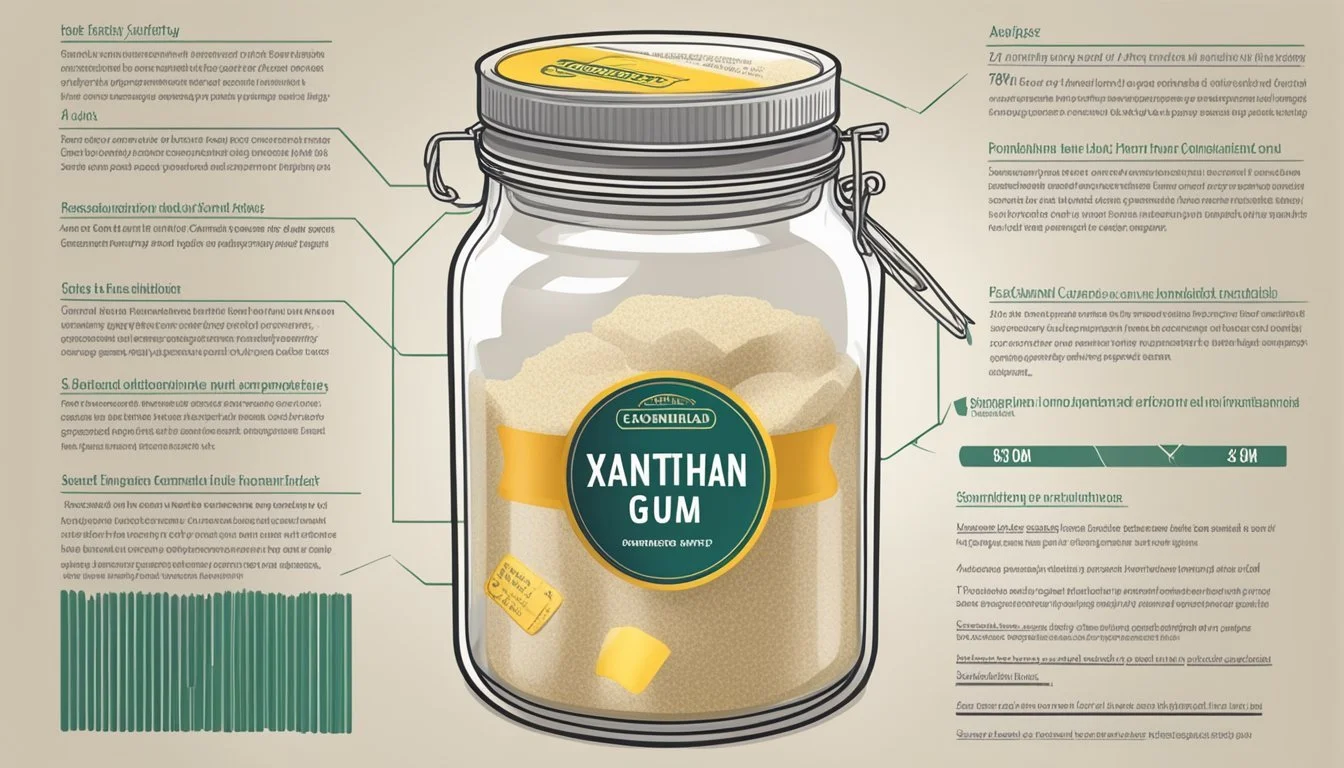How Much Xanthan Gum Is Safe to Consume?
Exploring Limits in Food Thickeners
Xanthan gum is a polysaccharide that acts as an effective thickening agent and stabilizer in a variety of food products and recipes. Derived from the bacterial coat of Xanthomonas campestris, it provides the desired texture in gluten-free baking and is often used in sauces and dressings. It is important to determine the safe consumption levels of xanthan gum, as with any food additive, to ensure it can be incorporated into diets without adverse effects.
The safety of xanthan gum for consumption has been evaluated by numerous regulatory organizations worldwide. The Food and Drug Administration (FDA) has classified xanthan gum as safe when used appropriately as a food additive. It is similarly recognized as safe by the European Food Safety Authority (EFSA) and other international food safety authorities. Consumption levels of xanthan gum vary depending on its use in specific food applications; however, it is regarded as safe for most people in typical amounts found in food products.
Determining the right amount of xanthan gum to use as a thickener can vary based on the recipe and the desired consistency. While manufacturers are guided by regulatory standards to ensure consumer safety, for home cooks, general usage recommendations suggest a small amount, often in the range of 0.1% to 0.3% by volume for thin sauces, can achieve the desired thickening effect. This equates to approximately 1/4 teaspoon of xanthan gum per cup of liquid, a guideline that needs to be adjusted as per the thickness required and the specific characteristics of the dish being prepared.
What Is Xanthan Gum?
Xanthan gum is a versatile polysaccharide used as a thickening agent in a myriad of products, known for its ability to improve texture and stability.
Origin and Production
Xanthan gum is produced through a fermentation process involving the bacterium Xanthomonas campestris. This bacterium ferments glucose, sucrose, or lactose to create the gum. Often, the carbohydrates used in this fermentation process are derived from corn.
Chemical Composition
The composition of xanthan gum is distinct; it's a long-chain polysaccharide composed of glucose, mannose, and glucuronic acid. The structure of these sugars gives xanthan gum its unique properties, such as its ability to bind water and create a viscous solution.
Physical Properties
Xanthan gum's physical characteristics make it particularly useful in food and industrial applications. It is highly soluble in both hot and cold water and can produce a broad range of viscosities. These properties allow for minute quantities of xanthan gum to have a significant thickening effect.
Food Applications of Xanthan Gum
Xanthan gum serves primarily as a thickening and stabilizing agent in a variety of food products, ensuring the right texture and consistency is achieved, particularly in gluten-free recipes where traditional thickeners like flour are not suitable.
Role as a Thickening Agent
Xanthan gum is a versatile thickener that maintains the texture and structure of many food products. Its efficacy as a thickening agent is apparent in a variety of applications:
Sauces and Dressings: Enhances viscosity, providing a silky and homogenous texture.
Ice Cream: Prevents ice crystals formation, contributing to a smooth and creamy consistency.
Baked Goods: In gluten-free baking, xanthan gum substitutes for gluten's role in providing elasticity and moisture retention.
Small quantities, typically ranging from 0.1% to 0.3% of the total weight, are sufficient for thickening most products, ensuring a stable end result without altering flavor.
Use in Gluten-Free Recipes
For individuals with gluten intolerance or celiac disease, xanthan gum is indispensable:
Breads and Muffins: Acts as a gluten substitute by providing the binding needed to hold these items together.
Soups: Offers a thickened base that mimics the mouthfeel of flour-based thickeners.
Its use in gluten-free products cannot be overstated, as it allows for a similar texture and structure that would otherwise be lacking in the absence of gluten.
Health and Nutrition
Xanthan gum, widely used as a food additive for its thickening and stabilizing properties, carries implications for both health benefits and potential risks. This section examines its dietary impacts and possible allergic reactions.
Dietary Benefits
Xanthan gum may contribute positively to health by functioning as a dietary fiber. It can slow the absorption of sugar, potentially aiding in the management of blood sugar levels. It is also known to act as a prebiotic, supporting gut health by fostering beneficial bacteria in the gut. These properties make xanthan gum valuable for those managing diabetes or looking to support their gastrointestinal health.
Potential Risks and Allergies
Despite the benefits, xanthan gum is not devoid of risks, especially when consumed in large quantities. Some individuals may experience digestive issues, such as increased gas, bloating, or changes in stool consistency. There's also a possibility for allergic reactions in people sensitive to xanthan gum or those with allergies to the bacteria Xanthomonas campestris, from which it is derived. Therefore, it is generally recommended to consume xanthan gum in moderation to minimize potential adverse effects.
Xanthan Gum in Daily Life
Xanthan gum's versatility extends well beyond its role as a thickening agent in food products. It also finds applications in personal care and other industries due to its unique properties that affect texture and consistency.
Culinary Uses Beyond Thickening
In the culinary world, xanthan gum serves various functions. When added to liquids, it acts as an emulsifier, helping oil and water to mix. This ability is particularly useful in making vinaigrettes and other dressings where separation of oil and water is common. Xanthan gum also helps in the stabilization of foams such as meringue or whipped cream, maintaining the desired airy texture by preventing collapse.
The gel-forming capacity of xanthan gum allows it to be used as a gelling agent in recipes like puddings or jams. Its effectiveness is not heavily affected by temperature changes, which makes it a dependable ingredient in the preparation of both hot and cold dishes.
Moreover, xanthan gum is a key component in gluten-free baking. It provides structure and elasticity to doughs made with gluten-free flours like rice flour, which lack the binding qualities of their wheat counterparts. Even in small quantities, xanthan gum can significantly improve the texture of gluten-free baked goods, making them resemble the chewiness and fluffiness of wheat-based items.
Personal Care and Other Uses
Xanthan gum's hydrating properties make it a favorable addition to personal care products. As a thickening agent, it transforms liquids into gels, improving the product's application and feel on the skin. Lotions, for example, benefit from xanthan gum as it ensures a smooth, consistent texture that is neither too liquid nor too thick.
In dental care products like toothpaste, xanthan gum acts as a binder that prevents ingredients from separating. It provides the right consistency that allows toothpaste to flow easily out of the tube but maintain shape on the toothbrush.
The stability provided by xanthan gum at various temperatures and pH levels makes it ideal for a range of other uses, including as a thickener in cosmetics like foundations and creams, enhancing product longevity and ease of use.
Safety and Consumption Guidelines
Consumers often encounter xanthan gum as a thickening agent in a variety of foods. Its consumption is subject to safety guidelines issued by regulatory bodies to ensure health risks are minimized. The following subsections delineate the specific recommendations of the U.S. Food and Drug Administration (FDA) and the established Acceptable Daily Intake (ADI) for xanthan gum.
FDA Recommendations
The FDA classifies xanthan gum as "generally recognized as safe" (GRAS) for use as a food additive. This designation implies that when used according to prescribed amounts, xanthan gum does not pose a significant risk of adverse side effects. It's important to note that while side effects can occur, they are typically associated with large quantities that exceed standard food amounts, and commonly include softer stools or changes in bowel movements.
Acceptable Daily Intake
The Acceptable Daily Intake for xanthan gum, recommended by the Joint FAO/WHO Expert Committee on Food Additives (JECFA), is set at 10 milligrams per kilogram of body weight per day. To provide context, for a 70 kg (approximately 154 lbs) adult, this means an ADI of 700 mg of xanthan gum is considered safe. It's crucial for food manufacturers and consumers to adhere to this guideline to avoid potential digestive issues that can arise from excessive consumption.
Considerations for Specific Conditions
When incorporating xanthan gum into a diet, individuals with certain health conditions should consider the potential effects on their specific situation. The following subsections outline how xanthan gum may interact with conditions such as diabetes and food allergies.
Implications for Diabetes
Patients with diabetes need to be aware of their blood sugar levels. Xanthan gum, used as a thickening agent, can influence the glycaemic response due to its soluble fiber content, potentially slowing digestion and helping to lower blood sugar levels. However, this effect can vary depending on the quantity consumed and one's overall diet.
Issues with Food Allergies
For those with food allergies, particularly to gluten, xanthan gum can be a safe alternative to gluten-containing thickeners. Nevertheless, xanthan gum is occasionally grown on wheat, soy, or corn substrates, which can introduce allergy concerns. They should seek products specifying that the xanthan gum is allergen-free or produced from non-allergenic substrates to avoid adverse reactions.
Practical Tips for Usage
When incorporating xanthan gum, it is crucial to achieve the desired texture without compromising consistency or taste. Precision in measuring and meticulous mixing are fundamental to the success of using it as a thickening agent for various culinary applications.
Measuring and Mixing
To ensure proper thickening, xanthan gum must be measured precisely. For smoothies, creams, and sauces, start with 1/8 teaspoon per cup of liquid and adjust as necessary. Accurate mixing is vital to avoid clumps. Combine the xanthan gum with the liquid using a blender to enable it to disperse evenly and thicken effectively. For batters or dough intended for bread or cakes, about 1/4 teaspoon per cup of flour is recommended, while syrups may require a different approach where the xanthan gum is blended after the syrup has cooled.
Cooking with Xanthan Gum
Xanthan gum works well in a variety of hot and cold applications. It can be used to thicken sauces and soups by blending it into the liquid before heating. When used in gluten-free dough recipes, xanthan gum adds elasticity, making it possible to shape the dough by hand. It stabilizes emulsions which is beneficial for dressings and non-dairy alternatives. Additionally, it can be employed in frozen foods, as it prevents the formation of ice crystals. For each application, ensure the xanthan gum is well integrated before cooking or baking to maintain a consistent texture.
Comparisons and Alternatives
In examining the safety and application of xanthan gum as a thickening agent, it's essential to consider its properties in contrast to other thickeners, as well as potential natural and synthetic substitutes that could replace it in various culinary and manufacturing contexts.
Xanthan Gum Versus Other Thickeners
Xanthan gum stands out for its exceptional ability to create a stable, uniform texture in food products, even under varying temperature and pH conditions. In contrast, other thickeners like cornstarch and gelatin have limitations; cornstarch can get clumpy and isn’t stable in freezing conditions, whereas gelatin requires refrigeration to set and isn’t suitable for vegans.
Thickener Temperature Stability Freezing Stability Vegan Friendly Xanthan Gum High Yes Yes Cornstarch Moderate No Yes Gelatin Low Yes, but requires setting No
Natural and Synthetic Substitutes
When considering substitutes for xanthan gum, both natural and synthetic options are available. Guar gum, derived from guar beans, is a natural alternative that shares similar thickening properties but may cause digestive issues in large amounts. Chia seeds, another natural option, form a gel when hydrated and can add fiber content to foods. Here are the key features of these substitutes:
Guar Gum: A natural thickener with similar properties to xanthan gum. It can, however, lead to increased gas or bloating.
Chia Seeds: These seeds absorb water to form a gel-like substance and are an excellent source of omega-3 fatty acids and fiber.
The alternatives mentioned offer different advantages and potential drawbacks, and their choice over xanthan gum would depend on the specific requirements of dietary needs, cooking methods, and textural preferences. Each thickener's suitability varies with the application and desired outcome, calling for a judicious selection based on the context.
Environmental and Ethical Considerations
When considering the safety of xanthan gum as a thickening agent, it is imperative to evaluate not only its impact on human health, but also its environmental and ethical implications. Xanthan gum is derived from the bacterial coating on plants, primarily from a sugar-containing medium.
Sustainability of the production process is a key concern. The bacteria (Xanthomonas campestris) utilized in the fermentation process require carbohydrates, which are often sourced from crops like corn, soy, or wheat. These crops demand substantial land and water resources, and their cultivation can lead to deforestation and biodiversity loss if not managed responsibly.
Environmentally friendly practices in the production of xanthan gum include:
Utilizing waste products from other agricultural processes as feedstock, promoting a circular economy.
Implementing energy-efficient fermentation techniques to reduce greenhouse gas emissions.
Seeking certification from recognized environmental organizations to assure consumers of sustainable practices.
In terms of ethical considerations, the labor practices within the agricultural segments that provide raw materials for xanthan gum production are of concern. Ethical sourcing means ensuring:
Fair labor practices and adequate working conditions for all workers involved in the production chain.
Transparency in sourcing with traceable supply lines.
Initiatives that support local communities and contribute positively to socioeconomic factors.
Consumers interested in these aspects should look for products that use xanthan gum from producers committed to sustainable and ethical practices. Manufacturers can contribute by opting for certified sources and promoting transparency in their production processes.








